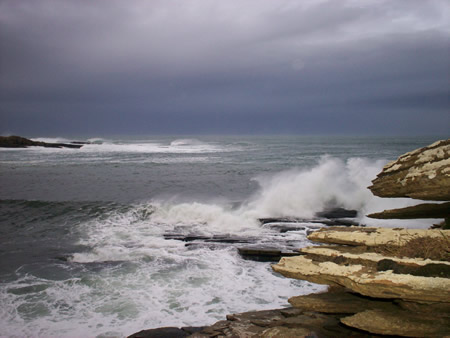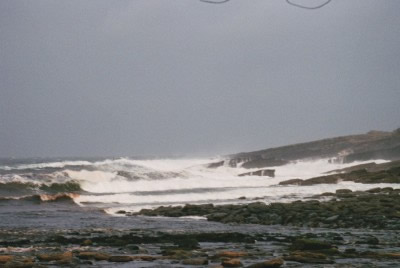These bulletin blogs represent news about Finavon and the South Esk, and my views as a riparian owner. They are not the views of any other organisation, nor are they designed to promote the interests of any individual or organisation other than Finavon Castle Water and factors affecting the fishery. Tony Andrews
To today’s date the Montrose team of scientists have tagged 71 MSW salmon. As reported previously, 9 have entered the South Esk and 3 of these fish have dropped back below the most downstream of the receivers at Bridge of Dun. There has, rather surprisingly given the good water levels, been no new fish into the River, although considerable movement of fish within it.
Rough seas slow progress with radio tagging spring salmon
Conditions have been difficult over the last two weeks, with rough seas for much of the time making it impossible to work the nets and tag fish, so it is encouraging that tagging targets are being met and the planned number of 150 fish tagged by the end of May well within reach.
For those people who regard this project as a waste of time, and criticise the possible award of a licence to Usan Fisheries to continue netting into September, it is worth stating that the fish caught and tagged in May, of which there are likely to be about 80, would normally be killed and sent to market by Usan Fisheries. These MSW salmon caught in May are the most valuable fish of the season and represent a significant part of the Usan Fisheries income. I leave it to my readers to decide for themselves whether a licence to fish in September represents a sensible or fair way of compensating the Pullars for releasing those tagged salmon caught in May. It is important however to note that the licence has not been confirmed; the Minister’s decision merely flagged it as a possibility.
The other news is that 3 fish were recorded in the North Esk on the 20th April, of which one was radio-tagged on the 15th of March. In other words this salmon stayed at sea for the period 15/3 to 20/4 before choosing to enter its river. This is an interesting aspect of salmon behaviour which we may speculate could be accounted for by the long period of low water, or by the strong east winds and associated coastal turbulence. Whatever the reason, it is fascinating to learn that salmon will hang around off the coast for a period of weeks before migrating into the river. Of course, during that period these fish will have been vulnerable to predation.
To summarise, 16.9% (12) of the fish tagged to date (71) have been recorded in the North Esk (3) and South Esk (9). Because no fish have been recorded in rivers Dee or Tay, and because the technology appears to be working OK, we may assume that the other 83.1% of salmon tagged so far (59) are either still at sea or dead.
Moreover, one thing we now know for certain, following the recordings from the North Esk, is that the Usan nets are a mixed stocks fishery, but we knew that from previous tagging. Nevertheless, it is useful to know that Usan nets are exploiting our scarce spring salmon on a mixed stocks basis.
Tracking within the catchment: Of course, other important information will come from the movements of tagged fish within the South Esk catchment, this being the primary purpose of the research project. It is worth repeating that the aim of the project is to identify the specific spawning locations of the spring components of the South Esk stock of wild Atlantic salmon. With this data should come a better understanding of which tributaries have the geological, topographical and chemical characteristics to support spring salmon. We can then assess the condition of these sections of the river system with a view to improving the habitats on a remedial basis. Typically these so called “spring fish” will be multi sea-winter salmon, mostly from 2SW and 3SW groups. It is extremely unlikely, during the period of tagging (16/2 to 31/5), that any grilse (1SW salmon) will be caught, although in the second half of May there is a possibility of early running grilse, usually male fish from the same genetic group as some of the earlier running females, being caught in the nets, but they will probably not be radio-tagged
While I am not seeking to be controversial, I hope that detractors of this project might desist from complaining, and start paying attention to the facts that are starting to emerge – even at this early stage. While we clearly need a much bigger sample than the 12 fish we have so far recorded, it is fair to claim that the delays of salmon entering the rivers provides useful information about their migratory behaviour. We need all the data we can get if we are to conserve the valuable spring components of the South Esk’s stock.
TA on 20/4/2012

